
Voici la correction de la phrase en anglais :
“Have you ever felt that deep frustration when you say, ‘I can’t concentrate,’ as tasks pile up on your desk?”
This feeling is not isolated to a few; it resonates with many professionals, students, and people from all walks of life in our hyper-connected society.
Concentration, the ability to direct our full attention to a task or subject, seems increasingly difficult to maintain in today’s world.
Yet the ability to concentrate is more essential than ever.
In this article, we’ll explore concrete methods and strategies for improving concentration.
We’ll delve into the root causes of concentration difficulties, understand the underlying mechanisms that govern our attention, and discover practical tips to boost your ability to stay focused, even in noisy and distracting environments.
Summary of key points covered in the article
| Section | Key Points |
|---|---|
| Introduction | The difficulty of maintaining concentration in our hyperconnected society and the importance of this skill. |
| Understanding Concentration Difficulties | Influence of the digital environment, impact of multitasking, and effects of stress, anxiety, and lack of sleep on concentration. |
| The Science Behind Concentration | Role of the prefrontal cortex and neurotransmitters in concentration, and impact of sleep and diet on brain health. |
| Identifying Your Personal Barriers to Concentration | Importance of recognizing personal and environmental obstacles to concentration. |
| Effective Time Management for Better Concentration | Recognizing one’s own work rhythms, the usefulness of breaks, and the art of delegating. |
| Mindfulness Techniques to Improve Concentration | Benefits of mindfulness in managing internal distractions and developing mental presence. |
| Nutrition and Concentration | Impact of nutrition, like flavonoids and lean proteins, on concentration. |
| The Role of Sleep in Concentration | Impact of sleep on memory consolidation and emotion regulation, and importance of good sleep hygiene. |
| Physical Exercise and its Impact on Concentration | Benefits of regular physical exercise on neuroplasticity, stress management, and concentration. |
| Creating an Environment Conducive to Concentration | Importance of adequate lighting, especially natural light, to improve concentration. |
| Prioritizing Tasks for Better Focus | Importance of prioritizing and eliminating superfluous tasks, setting realistic boundaries and deadlines, and using Time Blocking technique. |
| Technology and Concentration | Management of technology use through self-discipline, customization of notifications, and using technology to create a concentration-friendly environment. |
| Staying Focused in a Distracted World | Establishing daily routines, visualization, adapting the work environment, stress management, and setting boundaries with others. |
| Overcoming Procrastination | Self-reflection, developing self-compassion, implementing systems and processes, collaboration, and flexibility. |
| The Importance of Regular Breaks | Choosing beneficial break activities, complete disconnection during breaks, and the importance of timing and environment of breaks. |
| Cognitive Exercises to Improve Concentration | Using memorization techniques, strategy games, reading and analyzing complex texts, and other activities that require active learning. |
| Managing Anxiety and Stress | Time management, practice of writing, physical exercise, creating a support network, and recognizing the need for professional help. |
| The Power of Positive Thinking | Using positive visualization, adopting an attitude of gratitude, positive self-suggestion, and creating an environment that supports positive thinking. |
| Setting Realistic Goals | Celebrating small victories, using back-planning technique, integrating feedback, and setting balanced goals. |
Understanding Concentration Difficulties

Concentration, in its essence, is the act of directing and maintaining one’s attention on a specific task or subject.
This ability, however, is influenced by a multitude of factors that can either facilitate or compromise it.
Among these factors, the digital environment in which we live plays a significant role.
Smartphones, for example, are designed to capture our attention: notifications, alerts, and messages are all stimuli that constantly solicit our brains, forcing us to divert our attention from our current tasks.
Because of this, some people develop a real dependence on smartphones.
This phenomenon is exacerbated by social media and online platforms, which use algorithms to keep us engaged and active for as long as possible.
Furthermore, the culture of productivity at all costs, which values multitasking, hurts our ability to concentrate.
The myth that doing several things at once makes us more efficient has been widely debunked by various studies.
In reality, switching from one task to another only fragment our attention, reducing our efficiency and ability to process information in depth.
In addition, personal factors such as stress, anxiety, lack of sleep, and an unbalanced diet can greatly affect our concentration.
Chronic stress and anxiety, in particular, activate our body’s stress response system, diverting energy and brain resources needed for concentration.
Similarly, even mild sleep deprivation can decrease alertness and weaken the mind’s ability to maintain sustained attention.
Finally, it is important to take into account underlying health conditions, such as Attention Deficit Hyperactivity Disorder (ADHD), which can significantly impact the ability to concentrate.
Hormonal imbalances or neurological issues can also play a role.
To manage these challenges and improve concentration, it is essential to adopt a holistic approach.
This can include setting clear boundaries with technology, practicing mindfulness to improve stress management, adopting good sleep habits, and a balanced diet, and, if necessary, seeking medical or therapeutic support for underlying health conditions.
By understanding and addressing these different factors, we can work to improve our concentration and, by extension, our productivity and overall well-being.
The Science Behind Concentration
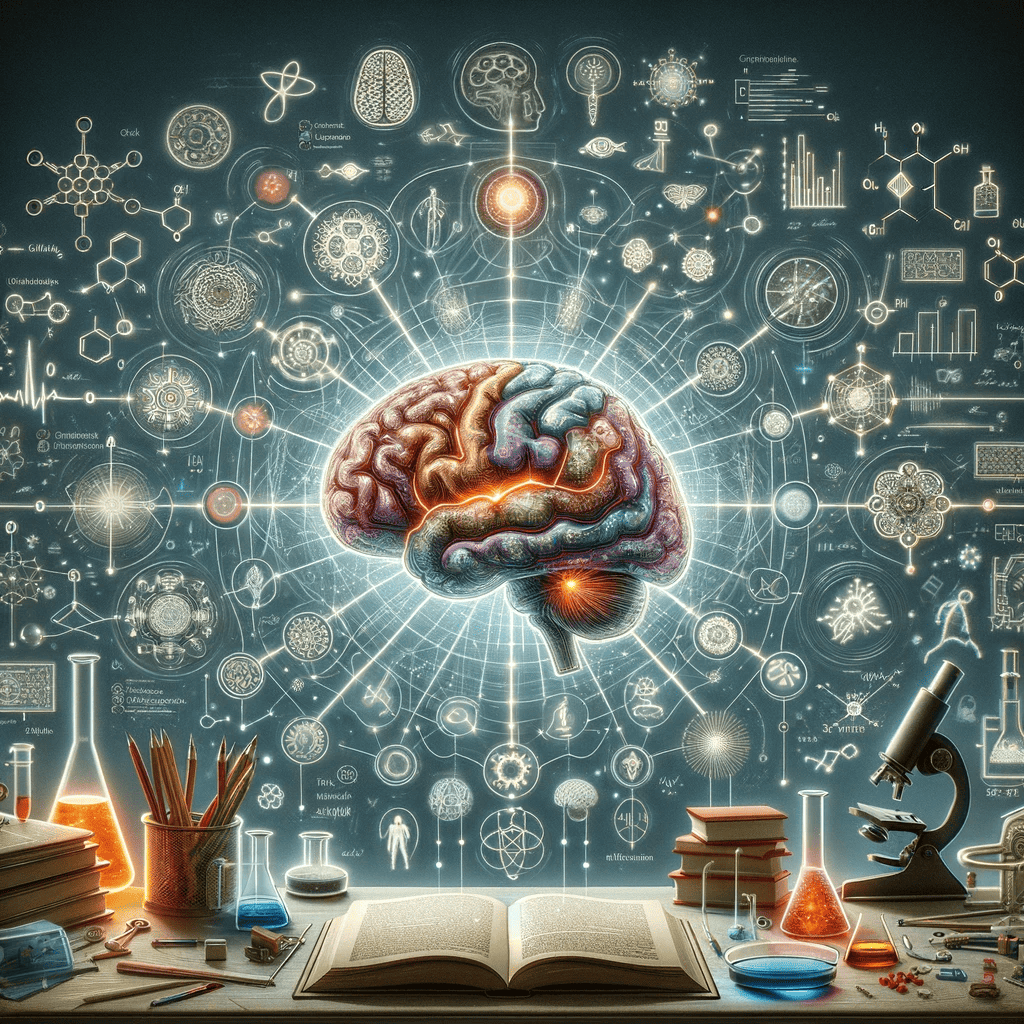
Concentration is largely regulated by the prefrontal cortex, a region of the brain involved in complex planning, decision-making, and moderating social behaviors.
This cortex works in tandem with other parts of the brain, such as the limbic system, which manages our emotions and stress responses, to allow us to focus despite potential distractions.
The interaction between these brain regions is complex and can be influenced by our environment and experiences.
A fascinating aspect of concentration is its link with neurotransmitters, the brain’s chemical messengers.
Dopamine, often associated with the brain’s reward system, plays a key role in motivation and attention.
A balanced level of dopamine is essential for maintaining concentration and motivation.
Noradrenaline, on the other hand, is linked to arousal and reactivity.
It helps us stay alert and focused, especially in stressful or new situations.
The optimal functioning of our brain and our ability to concentrate is also influenced by other physiological factors.
For example, our sleep cycles directly impact the brain’s ability to focus.
During sleep, particularly during deep sleep and REM sleep, the brain processes information, consolidates memory, and recovers from daily fatigue.
Insufficient or poor-quality sleep can lead to a decrease in concentration and cognitive ability.
Furthermore, our diet plays a significant role in the health of our brains.
A balanced diet, rich in essential nutrients, can support cognitive function.
For example, omega-3 fatty acids, found in fish and certain seeds, are vital for neuronal health and can improve concentration.
Similarly, antioxidants present in fruits and vegetables protect brain cells against damage from oxidative stress, thus contributing to better brain health.
By understanding the complex science behind concentration, we can better appreciate the importance of taking care of our brain, whether through exercise, good nutrition, adequate sleep, or even medical support if necessary.
This not only helps us improve our concentration but also our overall well-being.
Identify your Barriers to Concentration

Understanding and identifying your obstacles to concentration is an essential introspective process.
These obstacles can vary considerably from one person to another and even for the same person under different circumstances.
In addition to the environmental and internal distractions already mentioned, other subtle factors can hinder your concentration.
For example, ergonomic issues such as an uncomfortable chair or poor layout of your workspace can insidiously divert your attention.
Environmental factors, such as inadequate lighting or an uncomfortable temperature, can also reduce your ability to concentrate without you being fully aware of it.
As for internal distractions, they are not limited to just worries or intrusive thoughts.
Sometimes, underlying health issues such as hyperactivity, mood disorders, or even dehydration and hunger can significantly impact your concentration. Therefore, it is crucial to pay attention to your overall physical and mental well-being.
To identify these barriers, a concentration journal can be a valuable tool.
By noting the moments when your concentration wanes and the surrounding circumstances, you can begin to discern patterns.
You may notice that your concentration decreases after a certain time of the day, indicating a need for a break or hunger, or that certain environments are more conducive to your concentration than others.
That is why you should also adapt your schedule following your chronotype.
Once identified, these barriers can often be mitigated or eliminated.
For example, rearranging your workspace to make it more comfortable and less distracting can have an immediate impact on your ability to concentrate.
Similarly, if health issues are the cause of your concentration difficulties, consulting a health professional for tailored advice can be an important step.
It is also important to recognize that some barriers to concentration may be related to habits or lifestyles that require adjustment.
For example, developing a routine, improving your sleep habits, or adopting relaxation techniques can be effective ways to combat internal distractions.
In summary, identifying and managing your barriers to concentration requires both a practical and introspective approach.
By taking the time to analyze and adjust your habits, your environment, and your well-being, you can significantly improve your ability to concentrate.
Efficient Time Management for Better Concentration
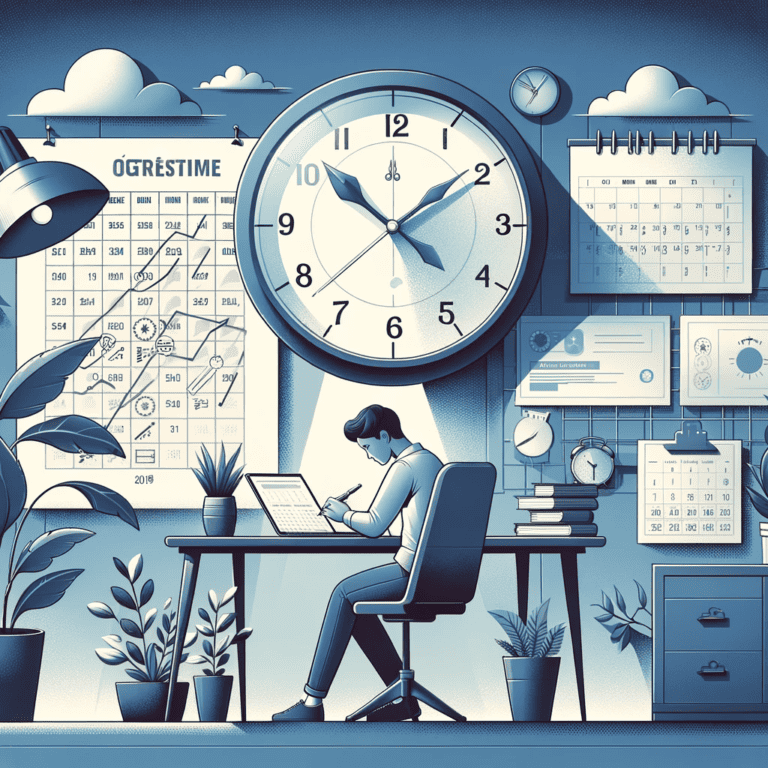
Effective time management goes beyond merely organizing tasks; it involves a deep understanding of your work rhythms and the ability to plan accordingly.
Everyone has times in the day when they are naturally more focused and productive – these periods should be identified and used wisely.
For instance, if you are more alert and focused in the morning, schedule your most demanding tasks during this time, and save less demanding activities for when your energy wanes.
But sometimes this is not enough, and it’s important to learn how to better plan your time.
Moreover, time management is not just about the quantity of work you can accomplish, but also the quality.
It’s crucial to recognize that uninterrupted work for long hours can often be counterproductive.
Regular breaks, even short ones, can refresh the mind and improve concentration.
The Pomodoro technique, mentioned earlier, is effective because it balances focused work with necessary breaks, thus preventing mental exhaustion and maintaining intellectual freshness.
Furthermore, the art of delegating is an essential aspect of effective time management.
Identifying tasks that specifically require your expertise and those that can be delegated to others not only lightens your workload but also allows you to focus on the tasks where you add the most value.
This requires trust in the abilities of your colleagues or employees, as well as clear communication about expectations and deadlines.
Additionally, learning to say no is a valuable skill.
This involves assessing requests based on their importance and urgency, and understanding that saying yes to everything can lead to overwork and a decrease in the quality of work.
Saying no to non-essential requests or those that do not align with your main goals can free up valuable time for more important tasks.
Finally, the use of time management tools and technologies can be of great help.
Time management applications can help you track your time, set reminders for breaks, and organize your tasks according to their priority.
Using these tools to plan and track your daily activities can bring clarity and structure that improves concentration.
In summary, effective time management for better concentration is not just a matter of planning; it’s also about knowing your limits, understanding your work rhythms, and using your time strategically to maximize productivity and quality of work.
For additional strategies on time management, discover our article on how to be more focused, which offers practical tips to effectively structure your time.
Mindfulness Techniques to Improve Concentration

Mindfulness, in its nature, is a form of meditation that teaches us to be fully present in the moment, welcoming and accepting our thoughts, feelings, and physical sensations without judgment.
This approach can be particularly beneficial for managing internal distractions, such as wandering thoughts or worries that can hinder concentration.
One of the most powerful aspects of mindfulness is its ability to train us to recognize and divert our attention away from distractions.
For example, when practicing mindfulness meditation, you learn to observe your thoughts and let them pass without attaching to them.
This develops an essential skill: the ability to recognize when one is distracted and to gently bring the attention back to the task at hand.
Incorporating mindfulness into daily activities is also a beneficial practice.
This can involve mindful eating, where you fully focus on the experience of eating – noticing the flavors, textures, and sensations associated with the act of eating.
Or during a walk, instead of being carried away by a stream of thoughts, focus on the experience of walking – the rhythm of the steps, the feeling of the ground under the feet, the air on the skin.
This practice helps to develop a mindfulness that is transferable to situations requiring concentration.
Moreover, mindfulness can be practiced through conscious breathing activities.
These exercises involve focusing on the rhythm and depth of breathing, which can be an effective way to refocus attention and reduce stress.
Conscious breathing serves as an anchor to bring the mind back to the present moment, a useful skill for staying focused.
Finally, mindfulness can be strengthened by the regular practice of seated meditation.
Dedicating time each day to sit quietly, close the eyes, and focus on the present moment can significantly improve the ability to concentrate.
This daily practice can serve as a foundation to strengthen concentration in all aspects of life.
Thus, mindfulness techniques are not just tools for improving concentration at the moment; they are practices that, when integrated into daily life, can transform our ability to focus and stay present in all our activities.
Nutrition and Concentration

The importance of nutrition in optimal brain function is an increasingly studied area.
Not only can the right foods improve concentration and memory, but they also play a crucial role in preventing cognitive decline.
For example, foods rich in flavonoids, like berries and dark chocolate, have been linked to improvements in various aspects of cognitive function, including memory and concentration.
Flavonoids are powerful antioxidants that help reduce inflammation in the brain and improve blood circulation.
Another key element of brain nutrition is blood sugar control.
Significant fluctuations in blood sugar can negatively affect your concentration and energy.
Low glycemic index foods, such as whole grains and most fruits and vegetables, release glucose into the bloodstream at a slower and more stable rate, promoting consistent concentration.
Lean proteins also play a vital role in concentration.
They are sources of amino acids like tryptophan, which is a precursor to serotonin, a neurotransmitter involved in regulating mood, sleep, and concentration.
High-quality protein sources include chicken, fish, eggs, legumes, and some dairy products.
Hydration is another crucial aspect of nutrition for good concentration. The brain is composed of about 75% water, and even mild dehydration can reduce its performance.
Drinking enough water throughout the day is vital for maintaining cognitive function and concentration at optimal levels.
Finally, the frequency and regularity of meals are important to consider.
Regular meals help maintain a stable energy level, avoiding concentration dips due to hunger or low blood glucose levels.
Healthy snacks, like fruits or nuts, can be useful for maintaining energy and concentration between meals.
In summary, a balanced diet, rich in essential nutrients for the brain and foods that promote a stable release of energy, is fundamental for optimal concentration.
By incorporating these elements into your daily diet, you can not only improve your concentration but also contribute to the overall health of your brain.
The Role of Sleep in Concentration
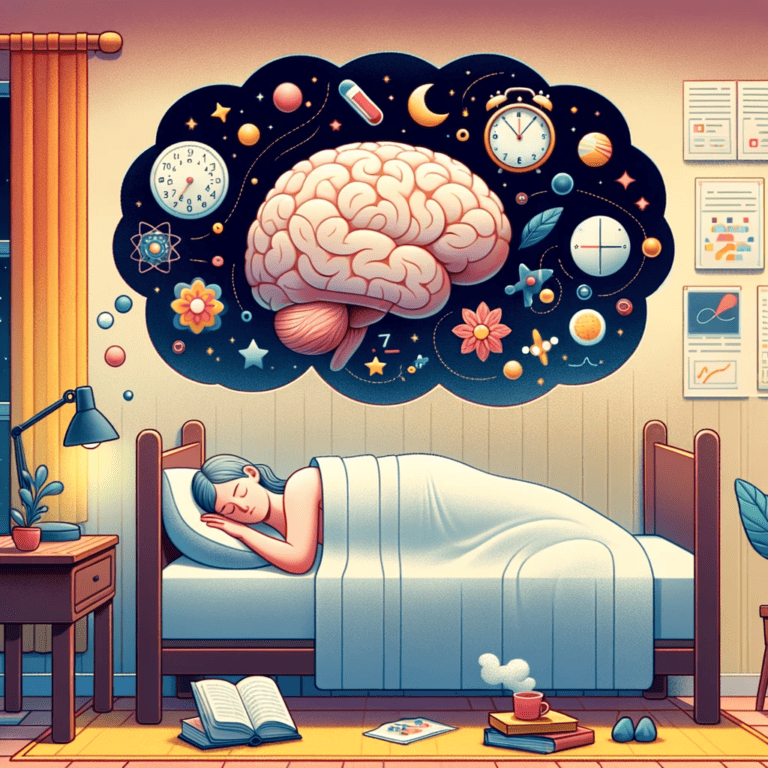
Sleep plays a vital role in the memory consolidation process, which is essential for learning new information and for effective concentration.
During sleep, particularly during deep sleep and REM (Rapid Eye Movement) phases, our brain processes and consolidates the experiences and information learned during the day.
This process is crucial for preparing the brain to absorb new information and concentrate the following day.
In addition to memory consolidation, sleep plays a role in regulating emotions.
Lack of sleep can increase emotional reactivity and decrease the ability to handle stress, which in turn can disrupt concentration.
Adequate sleep allows for better emotion regulation, thus promoting a more stable and focused state of mind.
The structure of sleep itself is also important.
Interrupted or poor-quality sleep can be just as detrimental as lack of sleep.
Sleep disorders such as sleep apnea or insomnia can negatively impact the quality of sleep and, consequently, concentration.
If you suspect a sleep disorder, it is advisable to consult a healthcare professional.
To promote quality sleep, it is also important to pay attention to sleep hygiene.
This includes creating an environment conducive to sleep – a dark, quiet room at a comfortable temperature.
Avoiding caffeine and heavy meals before bedtime can also contribute to more restorative sleep.
Finally, establishing a regular sleep routine is helpful.
Going to bed and waking up at the same time each day, even on weekends, can help regulate your body’s internal clock and improve the quality of your sleep.
By maintaining a regular sleep routine and adopting good sleep hygiene practices, you can improve your ability to concentrate and stay productive throughout the day.
In summary, quality sleep is a fundamental pillar for good concentration and optimal cognitive performance.
By paying special attention to the quality and regularity of your sleep, you can significantly improve your ability to concentrate and be effective in your daily activities.
Physical exercise and its impact on concentration
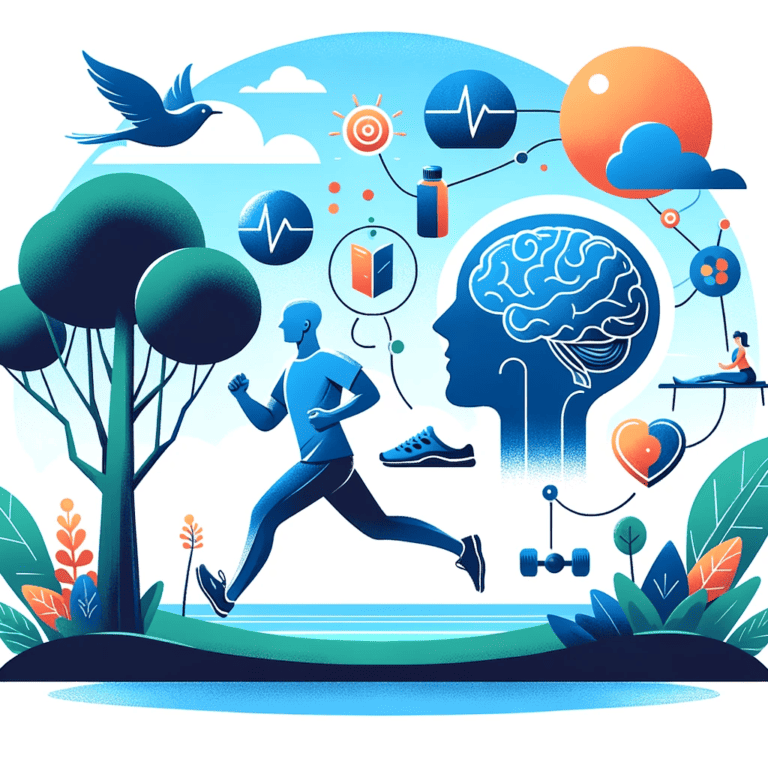
Regular physical exercise has a beneficial effect on neuroplasticity, the brain’s ability to reconfigure and develop throughout life.
Physical activity stimulates the production of neurotrophic factors, such as Brain-Derived Neurotrophic Factor (BDNF), which promotes the growth and survival of neurons.
This leads not only to better neuronal health but also to improvements in cognitive functions, including concentration and memory.
Furthermore, physical exercise can improve the management of stress and anxiety, two factors that can strongly impact concentration.
Regular exercise helps to regulate stress hormones, such as cortisol and increases the production of endorphins, often referred to as the well-being hormones.
This can lead to a reduction in feelings of anxiety and an improvement in mood, thus creating a mindset more conducive to concentration.
The regularity of exercise is also important. Incorporating physical activity into your daily routine, even in the form of short sessions, can provide consistent benefits in terms of concentration and cognitive performance.
Activities like yoga and Tai Chi, which combine movement and mindfulness, can be particularly beneficial for improving concentration, as they teach focusing attention while engaging the body.
It is also interesting to note that exercise has a positive effect on sleep.
Better quality sleep, facilitated by regular exercise, plays a crucial role in concentration ability and overall cognitive performance.
People who exercise regularly tend to benefit from deeper, more restorative sleep, which contributes to better concentration during the day.
Finally, physical exercise can be an excellent tool for breaking routine and getting out of a state of mental fatigue.
A short exercise session can rejuvenate the mind and provide a fresh burst of energy, allowing you to return to your tasks with a refreshed spirit and renewed concentration.
In summary, physical exercise is a crucial element not only for physical health but also for mental health and concentration ability.
By adopting a regular exercise routine, you can significantly improve your concentration, memory, and overall well-being.
Creating an environment conducive to concentration

The importance of lighting in your workspace is often underestimated.
Adequate lighting, preferably natural light, can not only reduce eye strain but also improve mood and concentration.
If natural light is not sufficient, opt for indirect lighting that mimics daylight.
Avoid harsh fluorescent lights that can cause discomfort and distraction.
The color of your workspace can also influence your ability to concentrate.
Soft and soothing colors, such as pale blue or green, can create a calm environment conducive to concentration.
Avoid bright and stimulating colors in areas where you need to concentrate for long periods.
Noise is another key factor. In a noisy environment, consider using earplugs or noise-canceling headphones.
For some, a constant background noise, such as white noise or nature sounds, can help mask sound distractions and promote concentration.
The layout of furniture and the ergonomics of your workspace are also important.
Ensure your desk and chair are comfortable and support good posture.
A well-thought-out layout, where frequently used items are easily accessible, can reduce unnecessary distractions and increase efficiency.
In addition, the presence of plants in the workspace can improve concentration.
Plants not only purify the air, but their presence can reduce stress and increase well-being, which is beneficial for concentration.
Finally, it is essential to maintain a tidy workspace. A cluttered desk can be a source of distraction and can subtly erode your ability to concentrate.
Take the time to organize your workspace regularly to maintain an environment conducive to concentration.
In summary, creating a work environment conducive to concentration requires attention to detail – from the lighting and color of your space to ergonomic aspects and noise management.
A well-designed environment can not only improve your concentration but also increase your efficiency and job satisfaction.
Prioritize Tasks for Better Focus
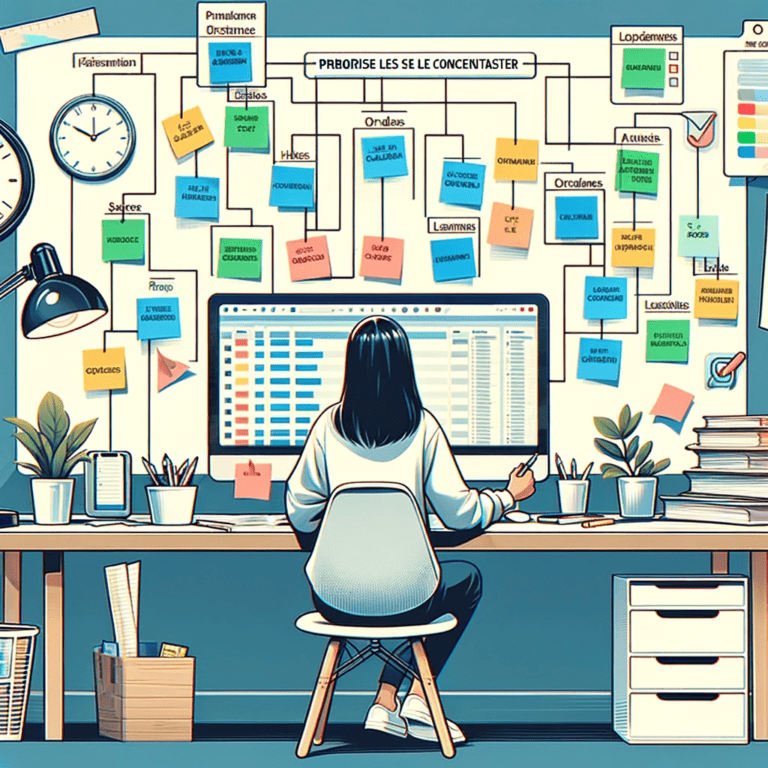
The art of prioritizing also involves recognizing and eliminating superfluous tasks that do not significantly contribute to your overall goals.
This may require an honest assessment of your daily activities and the willingness to set aside or delegate tasks that are not essential.
By eliminating superfluous tasks, you free up more time and mental energy to focus on what is truly important.
Another key aspect of prioritization is setting realistic boundaries and deadlines for each task.
Establishing clear deadlines can create a sense of urgency that can help maintain focus.
However, these deadlines must be achievable to avoid unnecessary stress that can impede concentration.
The time-blocking technique can also be useful in managing priority tasks.
It involves planning your day in blocks of time dedicated to specific tasks.
This approach can help you stay focused on one task at a time and avoid the pitfalls of multitasking.
It is also beneficial to regularly reevaluate your priorities.
What is important today may not be tomorrow.
Take time each week to reflect on your goals and adjust your priorities accordingly.
This ensures that you are devoting your energy to tasks that are most aligned with your current goals.
Moreover, practicing gratitude can play a role in effective task management.
By recognizing and appreciating what you have accomplished, rather than focusing solely on what remains to be done, you can reduce stress and improve your concentration.
Finally, don’t forget to reward yourself for completed tasks.
This can be as simple as taking a well-deserved break or indulging in a small pleasurable activity.
Rewarding yourself for completed tasks reinforces positive behaviors and can increase your motivation to stay focused on future tasks.
In conclusion, effectively prioritizing your tasks is crucial for maintaining good concentration.
By identifying the most important tasks, eliminating superfluous activities, setting realistic deadlines, and regularly reevaluating your priorities, you can not only improve your efficiency but also your job satisfaction and overall well-being.
Technology and Focus

Self-discipline plays a crucial role in managing technology use.
Setting personal rules, such as not checking emails or social media during the first few hours of the workday, can help establish a rhythm of uninterrupted concentration.
It is helpful to start the day by focusing on productive tasks rather than getting absorbed by online information streams.
Customizing notifications is another effective strategy.
Many apps and online services offer the option to customize alerts to minimize interruptions.
By allowing only essential notifications, you can significantly reduce the number of times your attention is diverted.
Using technology to create an environment conducive to concentration is also beneficial.
For example, ambient noise apps or music designed to enhance concentration can help create a sound environment that promotes focus.
Similarly, using smart lamps that adjust lighting based on the time of day can help maintain an optimal work rhythm.
Utilizing digital planning tools, like online calendars and project management apps, can also increase productivity.
These tools provide a clear overview of your tasks and deadlines, helping you to prioritize and organize your work more effectively.
Recognizing the need for disconnection is also important.
Establishing technology-free periods, especially during meals and before bedtime, can help reduce information overload and foster better concentration during working hours.
These moments of disconnection are essential for allowing the mind to rest and recover.
Finally, practicing mindfulness in technology use can be a powerful tool.
This involves being aware of how you use technology and regularly questioning whether it serves your goals or diverts your attention.
In summary, while technology can be a source of distraction, it can also be a powerful tool for improving concentration when used strategically.
By learning to manage your interaction with technology, you can not only improve your concentration but also your efficiency and job satisfaction.
Staying Focused in a Distracted World

Establishing daily routines can greatly assist in maintaining focus.
Setting up start and end-of-day rituals, like preparing your workspace in the morning or reviewing your accomplishments at the end of the day, can create a mental framework that fosters concentration.
These routines signal to your brain that it’s time to focus or relax, thus helping to separate work time from free time.
Visualization is another effective technique.
Before starting a task, take a moment to visualize how you will accomplish it.
This practice can strengthen your intention and focus, helping you stay on track despite external distractions.
Adapting your work environment to the task at hand can also enhance concentration.
For tasks requiring intense focus, choose a quiet and isolated environment.
For less demanding activities, a more dynamic environment or a change of scenery might be beneficial.
Using stress management techniques is also crucial for maintaining focus.
Stress can easily divert attention.
Practices such as breathing exercises, regular breaks for relaxation, and engaging in physical activities can help manage stress and improve concentration.
Setting clear boundaries with others is also important.
Communicating your times of intense concentration to colleagues, friends, or family can help minimize interruptions.
Using signals, like a sign or headphones, can indicate to others that you are in a period of focused work.
Finally, the regular practice of self-discipline can improve your ability to stay focused.
This can include voluntarily limiting technology use or resisting impulsive distractions.
As with any training, the more you practice self-discipline, the easier it becomes to maintain focus even in a distracting environment.
In summary, staying focused in a distracted world requires a combination of practical strategies, structured routines, stress management, and self-discipline.
By adopting these approaches, you can not only improve your concentration but also strengthen your resilience against the pervasive distractions of our modern world.
For more tips on how to stay focused in a distraction-filled environment, check out our detailed article on how to stay focused.
Overcoming Procrastination

Self-reflection is a powerful tool in the fight against procrastination.
Take time to reflect on your typical thought patterns and behaviors that lead to procrastination.
This may include a tendency to overestimate the difficulty of a task, underestimate the time needed to complete it, or overestimate your ability to work under pressure.
Recognizing these patterns can help you counteract them more effectively.
Developing self-compassion is also essential.
Be kind to yourself when struggling with procrastination.
Understanding that procrastination is a common human behavior can reduce feelings of guilt or shame that often exacerbate the problem.
Establishing systems and processes can help stop procrastination.
This can include planning work sessions at times when you are naturally more energetic or setting up routines that signal to your brain it’s time to focus.
Using visualization techniques can also be helpful.
Visualize the positive outcome of completing your task, including the long-term benefits, to bolster your motivation.
This method can help overcome the initial resistance to starting a task.
Collaborating with others can also provide additional motivation to overcome procrastination.
Working in a group or having an accountability partner can increase your commitment to completing your tasks.
Finally, practicing flexibility and adaptability is important.
If you find that certain methods are not working for you, be prepared to adjust your approach.
The ability to adapt and try new strategies is crucial in the fight against procrastination.
In summary, overcoming procrastination involves a combination of self-understanding, practical strategies to modify behaviors, and techniques to strengthen motivation and discipline.
By addressing procrastination from these various angles, you can increase your ability to stay focused and accomplish your tasks effectively and satisfactorily.
The Importance of Regular Breaks

The nature of break activities can vary depending on your personal needs and work environment.
For example, if your work is primarily sedentary, incorporating light physical activity during your breaks can be beneficial.
This could include stretching, yoga, or even a few minutes of brisk walking.
These activities not only help to revitalize the body but also to clear the mind.
Engaging in relaxing or enjoyable activities during breaks can also help reduce stress and recharge mental batteries.
This could be something as simple as reading a book, listening to music, or even practicing meditation or mindful breathing.
These activities can help create a mental contrast with work, offering genuine rest for your mind.
It’s also important to recognize that completely disconnecting from work during breaks is crucial.
This means resisting the urge to check emails or think about pending tasks.
A complete disconnection allows your mind to fully rest and return to tasks with renewed focus.
Another consideration is the timing of breaks.
Rather than waiting to feel exhausted or unfocused, it’s better to plan breaks at regular intervals.
This can help maintain a consistent level of energy and focus throughout the day.
The duration of breaks is also a factor to consider.
While the Pomodoro Technique suggests 5-minute breaks, some people may find it beneficial to take longer breaks after several work cycles.
Listening to your body and adjusting the length of breaks according to your individual needs is essential.
Finally, the environment in which you take your breaks can influence their effectiveness.
Finding a quiet and relaxing space, if possible, can enhance the quality of your breaks.
Even a change of environment, like stepping outside or settling into a common area, can provide mental and physical renewal.
In conclusion, taking regular breaks is an essential strategy for maintaining focus and avoiding mental burnout.
By incorporating mindful and restorative breaks into your work routine, you can not only improve your concentration but also your productivity and overall well-being.
To learn more about the importance of breaks, I recommend reading my article on how to allow yourself to take breaks at work.
Cognitive Exercises to Improve Concentration
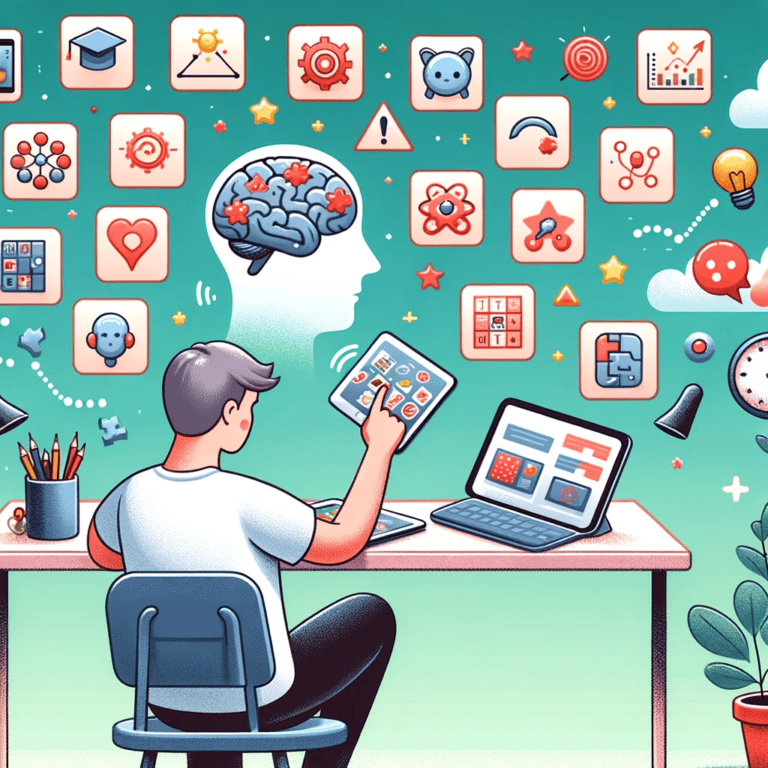
Using advanced memorization techniques can also be an excellent exercise to improve concentration.
Methods such as the loci system, where you associate information with locations in an imaginary mental space, can not only strengthen memory but also the ability to concentrate by actively involving different aspects of cognition.
Strategy games, like chess or card games that require planning and foresight, are also excellent ways to stimulate concentration.
These games demand sustained attention and strategic thinking, thereby intensively engaging cognitive capabilities.
Reading and analyzing complex texts can also be beneficial.
Engaging in readings that require critical thinking, such as classical literature or scientific essays, forces the brain to concentrate intensely to understand and interpret the information.
Practicing calligraphy or detailed drawing can also improve concentration.
These activities require meticulous attention to detail and hand-eye coordination, thus mobilizing your concentration in an intense and sustained manner.
Activities that require active learning, such as learning a new musical instrument or a new language, can also be extremely effective in strengthening concentration.
These activities engage multiple areas of the brain and require sustained attention and regular practice.
Finally, problem-solving exercises, like logical puzzles or riddles, are great ways to stimulate cognitive functions.
These exercises challenge the brain to find creative solutions, necessitating intense concentration and logical reasoning.
By incorporating these various cognitive exercises into your daily routine, you can not only improve your concentration but also stimulate overall brain activity.
These activities, ranging from memory games to problem-solving challenges, encourage the brain to work more intensively and efficiently, thus contributing to better concentration in daily tasks.
Managing Anxiety and Stress

The art of time management can play a crucial role in reducing stress and anxiety.
An effective and realistic planning of your tasks can lessen the feelings of being overwhelmed, which is often a major source of stress.
Learning to establish clear priorities and set achievable goals can help create a sense of control and competence, thereby reducing work-related anxiety.
The practice of writing or journaling can also be an effective tool for managing stress.
Taking the time to jot down your thoughts, worries, and daily successes can provide an outlet for expressing emotions, thus promoting increased mental clarity and better concentration.
Regular physical exercise is another effective method to reduce stress and anxiety.
Physical activity releases endorphins, and well-being hormones, and can improve sleep quality, thus contributing to an overall reduction in stress and better concentration.
Creating a strong support network, whether with friends, family, or colleagues, can also be beneficial.
Sharing your concerns and successes with others can help you feel less isolated and more supported in your efforts to manage stress.
Learning mindfulness in communication can also reduce stress and improve concentration.
Being fully present in interactions with others helps reduce misunderstandings and conflicts, which are often sources of stress.
Finally, it is important to recognize when it is necessary to seek professional help.
If stress or anxiety becomes overwhelming or significantly interferes with your daily life, it may be helpful to consult a mental health professional.
In summary, managing stress and anxiety to improve concentration involves a combination of practical strategies, such as effective time management and physical exercise, as well as emotional approaches like journaling and creating a support network.
By adopting these methods, you can not only effectively manage stress and anxiety but also improve your ability to concentrate and stay productive.
The Power of Positive Thinking

Using positive visualization is a powerful technique to foster a positive mindset. Imagine yourself succeeding in your tasks and achieving your goals.
This practice goes beyond superficial positive thinking; it helps you create a clear mental image of success, which can be a powerful driver of motivation and concentration.
Adopting an attitude of gratitude can also contribute to a positive mindset.
Take time each day to reflect on aspects of your life for which you are thankful.
This practice can help balance your perspective, reduce negative thoughts, and promote a more focused and positive mindset.
Practicing positive self-suggestion can also be effective.
This involves regularly repeating positive affirmations to bolster self-confidence and reduce negative thoughts.
These affirmations can be specific to your goals or more general about your self-esteem and abilities.
Creating an environment that supports positive thinking is also essential.
This may include surrounding yourself with people who encourage and support you, as well as creating a workspace that inspires and motivates.
Learning mental flexibility can help maintain a positive mindset.
This means being open to change and adaptable in the face of challenges, rather than being overwhelmed by obstacles or setbacks.
Finally, it is important to recognize that positive thinking does not mean ignoring challenges or difficulties.
On the contrary, it involves approaching them with a perspective that focuses on solutions and growth opportunities, rather than on failures or obstacles.
In summary, cultivating a positive mindset to improve concentration involves a series of practices ranging from positive visualization and gratitude to self-suggestion and mental flexibility.
By adopting these approaches, you can not only enhance your ability to concentrate but also strengthen your overall resilience and mental well-being.
Setting realistic goals
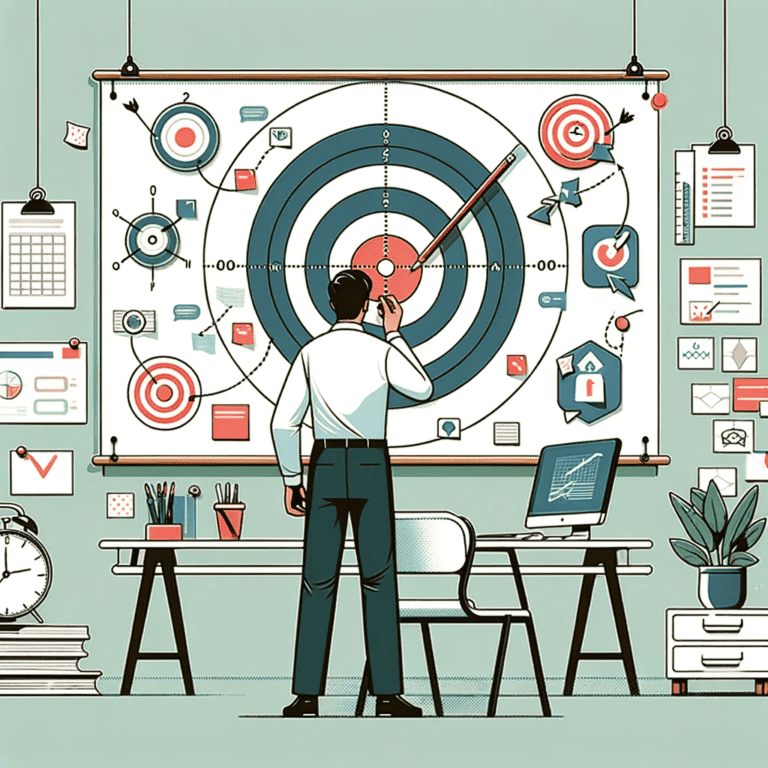
The importance of celebrating small victories in the goal-setting process should not be underestimated.
Recognizing and celebrating each small step accomplished towards achieving your goals can reinforce motivation and maintain a high level of concentration.
These small victories create a sense of progress and accomplishment that can boost ongoing commitment to your larger goals.
Implementing the ‘back-planning’ technique, or reverse planning, can also be effective.
Start by visualizing the final goal, then break it down into progressively smaller and more manageable steps until you reach the current step.
This method can help you see the clear path to your goal and maintain your focus on the immediate actions needed.
Incorporating feedback into the goal-setting process is also crucial.
Regularly reviewing your progress and adjusting your goals based on feedback can help keep you on track and maintain your focus.
This includes self-evaluation as well as seeking external feedback.
It is also important to keep your goals aligned with your values and personal interests.
Goals that are in harmony with your passions and your beliefs are more likely to motivate you and maintain your focus.
Moreover, learning to manage obstacles and failures is an integral part of setting realistic goals.
Viewing obstacles not as blockages, but as opportunities for learning and adjustment, can help maintain a positive and focused mindset.
Finally, it is essential to set balanced goals that take into account all aspects of your life, including work, health, leisure, and relationships.
A healthy balance among these different areas can contribute to better concentration and greater overall satisfaction.
In summary, setting realistic goals to improve concentration involves careful planning, celebrating progress, integrating feedback, aligning with personal values, managing obstacles, and maintaining a healthy balance.
By adopting this holistic approach, you can not only improve your concentration but also achieve your goals more effectively and satisfactorily.
Conclusion
Re-learning to concentrate is a challenge that many of us encounter in our daily lives.
However, with the right strategies and techniques, it is possible to significantly improve your ability to concentrate.
By understanding the factors that affect concentration, adopting healthy habits, and implementing specific techniques to manage time, stress, and the environment, you can improve your focus.
Remember, improving concentration is a gradual process that requires patience and practice.
By integrating these strategies into your daily routine, you’ll be able to increase your productivity and achieve your goals with greater efficiency.
If you are interested in the topic of productivity, I invite you to discover all my articles on productivity.
If you are looking for tools to improve your time management skills, I recommend you read my article on the best time management apps.
If you want to take advantage of the expertise of a time management coach, write to us now using our contact form or call us by phone or on WhatsApp at +33 6 69 46 03 79.
Are you ready to take action?
Here are the rates for our coaching packages for individual clients:
- one month coaching package
- 3-month coaching package
- 6-month coaching package
- 1-year coaching package
Frequently Asked Questions
How can I quickly improve my concentration during particularly busy days?
To quickly improve concentration, try deep breathing techniques or quick meditation. Even a few minutes of mindfulness can reset your mindset and sharpen your focus. Also, organize your tasks by priority and focus on one task at a time.
Are there specific foods that can help improve concentration?
Yes, certain foods are known for their ability to enhance cognitive function. Foods rich in omega-3s, like salmon, nuts, and chia seeds, as well as those high in antioxidants, like berries and dark chocolate, can help improve concentration.
How long should I take breaks between work sessions for optimal concentration?
The length of breaks can vary depending on the individual, but the Pomodoro Technique suggests a 5-minute break after every 25-minute work session. This helps prevent mental fatigue and keeps your mind fresh.
How does mindfulness help improve concentration?
Mindfulness helps train your brain to focus on the present moment and reduce mental distractions. It improves your brain’s ability to concentrate on a task without being distracted by intrusive thoughts or worries.
Can physical exercises improve concentration? If so, how?
Absolutely. Physical exercise increases blood flow to the brain, which enhances cognitive function and concentration. Activities like yoga, running, or even brisk walking can increase brain oxygenation, leading to better concentration.
How to manage technological distractions to improve concentration?
To manage technological distractions, try turning off non-essential notifications on your devices during work periods. Also, consider ‘tech-free’ work sessions where you put aside all electronic devices. Using website-blocking apps during work hours can also be helpful.
Read this article in other languages
Français : Je n’arrive pas à me concentrer : Techniques Clés pour un Focus Optimal
Italiano: Non riesco a concentrarmi: Tecniche chiave per una concentrazione ottimale
